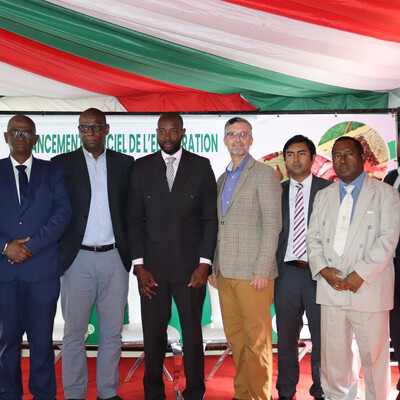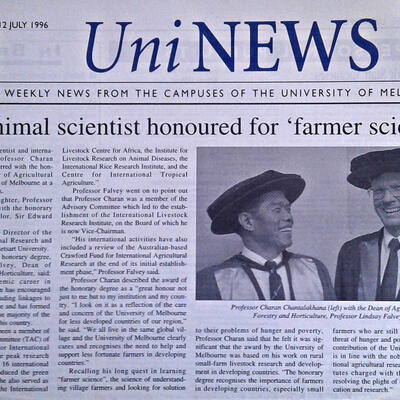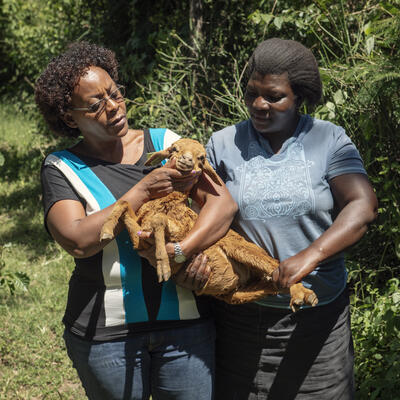
How DFAs are rejuvenating the dairy industry in Homa Bay and Siaya counties
 Okal Okoko, at his Okasambu Dairy Farm in Oyugis, Homa Bay
Okal Okoko, at his Okasambu Dairy Farm in Oyugis, Homa Bay
Before 2019, Kasbondo Dairy Cooperative, in Oyugis, Homa Bay County used to receive 300-350 litres of milk per day from less than 25 farmers with only three of them able supply 60 litres per day. Across the region in Siaya County, SAM Malanga Dairy Cooperative was equally struggling, only able to receive about 280 litres per day. Like many other dairy cooperatives in Nyanza and western Kenya, these volumes were too low for them to break even. Many were considering closing shop.
However, these low volumes of milk supplied to cooperatives masked the huge potential in these regions for dairy farming – good climate, more than enough land for fodder production, and a huge demand for dairy products. It is a fact that did not escape the United States Agency for International Development/Feed the Future’s Accelerated Value Chain Development (AVCD). After elaborate assessment of the dairy value chain in the regions, it became apparent that weak, unstructured, and scanty extension services and the resultant low technology adoption, low quantity and quality feed, and generally unskilled farm labour were the main causes of low milk production and milk supplies to the cooperatives.
To improve the dairy farming extension services, AVCD’s dairy value chain component introduced a private sector extension approach – the Dairy Farm Assistants (DFA) model in 2019 – that is being implemented in partnership with Heifer International and the livestock departments of respective county and national governments in the region. Under the model, the DFAs are attached to a particular dairy cooperative and are charged with providing extension services including facilitating technology dissemination and mobilizing milk supplies for the cooperatives.
Farmer mobilisation
‘My roles included among others mobilising farmers into the cooperative, providing artificial insemination services, training farmers on animal husbandry and herd management, and helping farmers establish fodder gardens,’ states Philip Ochieng Opar, one of the five DFAs attached to Kasbondo Dairy Cooperative.
One of their key targets was each of them to recruit at least 200 farmers into the Cooperative, a target they surpassed by January 2020 after recruiting 1,116 farmers. These farmers were organized into 29 common interest groups (CIG) with each group composed of a minimum of 30 members.
Breeding
Along with mobilisation, Opar an Animal Health graduate from Kenyatta University, spearheaded technology dissemination and farmer training on breeding, calf rearing, fodder establishment, feeding (preservation and presentation), and animal healthcare.
Of the 1,116 farmers recruited, only 100 had improved breeds. ‘We advised the farmers to improve their herds through artificial insemination or buy new improved ones,’ notes Apar.
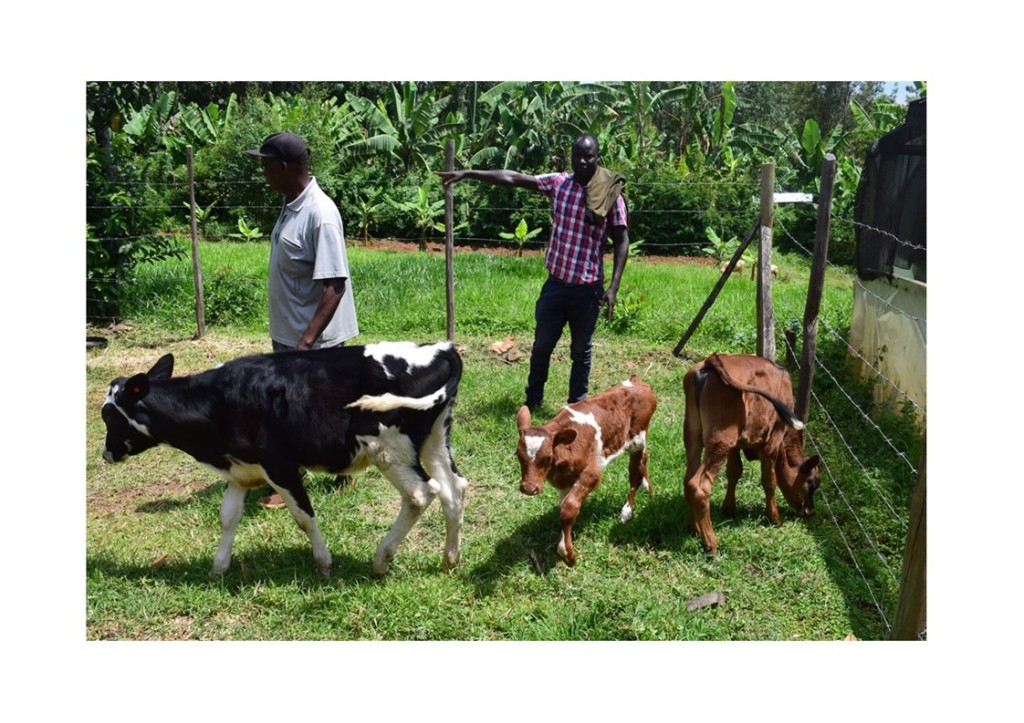 Philip Ochieng Opar (right), with Okal Okoko at Okasambu Dairy Farm in Oyugis, Homa Bay
Philip Ochieng Opar (right), with Okal Okoko at Okasambu Dairy Farm in Oyugis, Homa BayConsidering that about 90% of the farmers had local herds, the dairy component of AVCD introduced and implemented Fixed Time Artificial Insemination (FTAI) to accelerate upgrading of indigenous cows. ‘Our target was to provide FTAI services to 600 animals between March and December 2020. Our strategy was for every CIG to avail at least 30 cows for FTAI and it helped. We ended up inseminating 800 cows during that period. This was not a mean achievement, given how low the uptake of artificial insemination technology in the region has been over the years. By June 2021, the exercise had produced 303 heifers and 41 calves,’ states Opar. More calves were expected in the third quarter of 2021.
The dairy value chain component provided the FTAI services at highly subsidised rates to encourage more households to adopt artificial insemination technology. Through improved linkages with genetic material suppliers and leveraging the FTAI support infrastructure, AVCD enabled service providers like Mr Opar to also offer normal AI services at highly affordable prices of 1,000 shillings . Market prices for normal artificial insemination ranges between Ksh 2,000 – 3,000 per service. Under the subsidy arrangement, the dairy component has contracted Livestock Genetic Centre of the Agricultural Development Corporation, Kitale to supply liquid nitrogen and semen for FTAI. Each cooperative is supplied with seed semen by the dairy component, which they sell to their contracted AI service providers at a margin to enable them to grow the seeded semen bank.
Improving availability of feeds and forages
The component also introduced and scaled up production of improved, high yielding and protein dense forages such as brachiaria and panicum grasses for good animal health and productivity. One of Opar’s tasks was to ensure that farmers are aware and knowledgeable through training on animal feeding requirement, fodder production and processing especially for brachiaria and newly introduced panicum grass. The trainings focussed on fodder characteristics, yield potential, seed requirement and agronomy, planting and spacing, soil fertility requirement, maturity period and utilization.
Through this support, the 29 groups in the catchment of Kasbondo Dairy established 33 nurseries for brachiaria grass species. The groups were provided with 25 kg of Brachiaria seeds in March 2020 for multiplication. Mature seedlings were transplanted on 115 acres in the catchment of Kasbondo. By 2021, the acreage under fodder (mainly brachiaria) had shot up almost 10-fold – to 915 acres fuelled by the growing demand for fodder from the increased dairy herd in the region.
Towards commercialization of the forage seed system, the forages were also promoted under a subsidy program. Panicum, which was introduced in March 2021 and promoted through partnership with Advantage Crops LTD (ACL) – a local forage seed supply company, was availed to farmers at 60% subsidy while the previously introduced brachiaria varieties were availed at 30% subsidy. In Homa Bay, the market price for seeds of both grass varieties is 3,700 shillings per kg. With the subsidy, panicum grass seeds has been retailing at only at 1,500 shillings/kg. The subsidy program was only for 4 months to demonstrate the beneficial traits of the new varieties and therefore stimulate demand that would subsequently be met by supplies from ACL.
ACL trained 14 DFAs and 57 farmers on establishment of panicum grass. The training culminated in the establishment of panicum grass nurseries with a total of 14 nurseries being established across the six cooperatives in Migori, Homa Bay, Siaya and Kisumu counties. However, high prices have discouraged farmers from widely growing panicum despite its good attributes such as fast maturing (8-10 weeks after germination), faster re-growth (cutting every 4-6 weeks), and biomass production of up to 40 tonnes per hectare per year. In Homa Bay for instance, only about 10 acres of panicum grass have been established.
Impacting business skills.
‘For most of the farmers, keeping livestock or dairy cows was more of a calling than a business. Many had no idea whether they were making profits, losses or breaking even. Through training, we helped these farmers approach dairy farming as a business. We helped them develop targeted business models that differed from farmer to farmer. While we targeted to reach 300 farmers, we reached 500 farmers. From their records, many are now breaking even,’ says Opar.
The impact
The role and impact of DFAs in revitalising the dairy value chain and particularly in facilitating technology dissemination and mobilizing milk supplies for the cooperatives in Nyanza is now evident and appreciated. Mr Okal Okoko attributes his change in fortunes in dairy farming to the close working relationship with Opar.
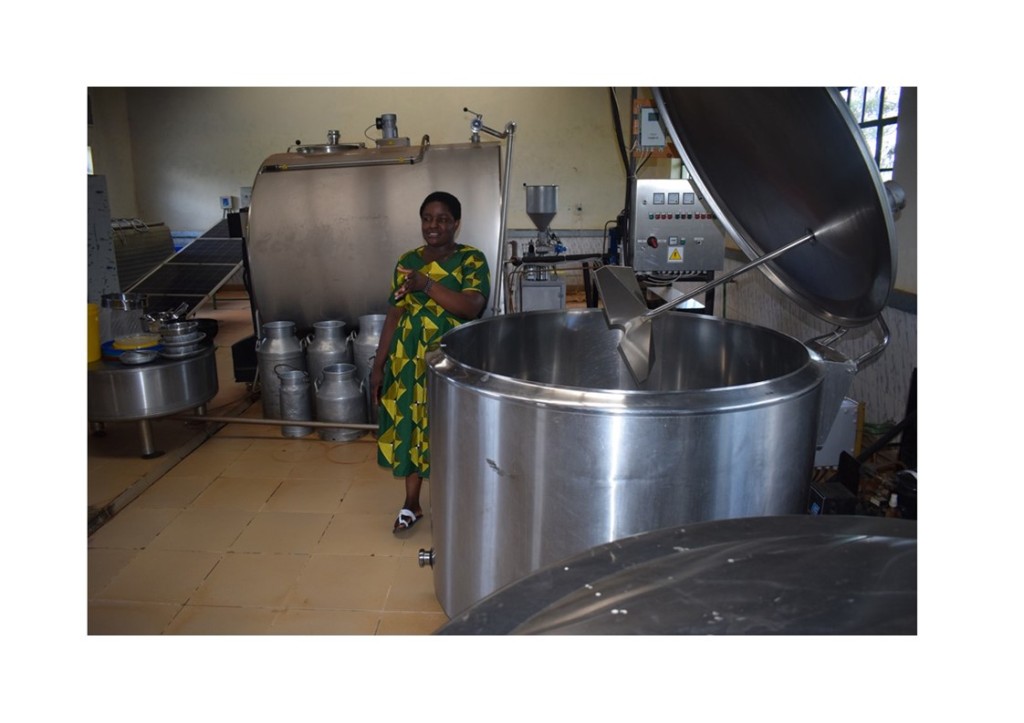 Perrine Osong’, Manager, SAM Malanga Dairy Cooperative at milk process plant
Perrine Osong’, Manager, SAM Malanga Dairy Cooperative at milk process plant‘Opar is like my technical manager. His constant visits, advise, one-on-one trainings on various aspects of dairy farming, from breeding, animal husbandry to fodder and feeding requirements have ensured I professionally look after my herd of dairy cows and keep them healthy and productive,’ states Okoko, a retired crops officer with the Kenya Agricultural and Livestock Research Organization. Okoko has increased his dairy herd from four to 10 cows and built a modern shed since Opar started visiting him in 2019. Okoko is one of the over 6,000 farmers the DFAs have reached with advisory services in Nyanza.
Supplies to the dairy cooperatives in the region have more than doubled. For instance, milk supplies to Kasbondo Dairy have increased to 750-800 litres per day with some farmers supplying between 110 and 150 litres per day. It is the same for SAM Malanga where the supplies have also increased to 500 litres per day. In November 2019, Kasbondo and SAM Malanga recruited five and three DFAs respectively.
‘These DFAs have really assisted the cooperative to mobilise more farmers, to train the farmers on various aspects of dairy farming and improved productivity. Through their efforts, we have seen a steady increase in milk supplied to the dairy cooperative and especially after the impacts of COVID-19,’ states Perrine Osong’ Manager, SAM Malanga Dairy Cooperative adding, ‘Even though their contracts under Heifer international are about to end, we have decided to retain all the three DFAs under our payroll.








